Here is mine:
Axis & Allies 1946
A 3 player game set in an alternate history where the USA failed to develop the atom bomb or decided not to use it, so they have to go into the islands of Japan and fight it out. Players control Japan, Russia, or America. The power that occupies Tokyo at the end of round 20 wins the game (if each round is 3 months that would be 1950ish). Russia and America start out as allies but their goal is to take Japan for themselves. They start out using each other to help eliminate Japan’s ability to make war, but only because they both know they can’t do it by themselves; they will declare war on each other as soon as they think it is to their own advantage. Manchuria is a pro-Soviet neutral with an enormous stock of infantry and North Korea is a pro-Allies neutral with a few infantry and an IC.
America starts the game with large naval and air forces at bases in Okinawa and Iwojima, plus they control South Korea and its IC. There are no IPCs in this game but America can mobilize up to 3 units of any kind per turn at Seoul. America can also mobilize more units if they can capture or activate other ICs (ie if they capture a minor IC they can mobilize 3 there plus the 3 in Seoul). There are several sea zones that may be convoy raided to reduce the number of American units that can be mobilized in Seoul or other US-occupied ICs. There are no IPCs in the game because it is assumed that both USA and USSR are limited by supply rather than by industrial production (ie limitless materiel coming in by rail or by sea from elsewhere); Japan’s production has been reduced to cottage industries by this stage of the war. Note that transports must be used to get ground units from Korea or Vladivostock to Japanese islands. New ICs, naval and air bases cannot be built but SBR damage can be repaired.
Russia starts out with a very small military presence but has a major IC in Vladivostock that can mobilize up to 10 units of any type per turn, minus any SBR damage. President MacArthur (congress actually) has forbidden US forces to attack originally Soviet territories using ground troops unless the Soviet Union activates Manchuria. SBR damage to Vladivostock or other Soviet controlled ICs is repaired for “free” at the end of Russia’s turn, but the number of units mobilized is declared at the start of the turn and may be reduced by SBR damage.
Japan starts out with some air units, a few subs and surface ships, and enormous reserves of infantry plus the odd AA, mech, artillery or armor unit. Each city also starts with a fixed number of civilians who can be mobilized into infantry (eg a small city like Hiroshima might start the game with a stack of 30 unmobilized civilians; a big city like Tokyo might have 500, etc.) Each city has either a minor IC that can convert up to 3 civilians into infantry or a major IC that can convert up to 10. The number of civilians that can be called up is reduced by SBR damage. Damage points can be removed at a cost of 2 civilians per damage point. Again there are no IPCs in the game to keep track of, but losses are measured in civilian deaths. Civilians attack at 0, defend at 0, have mobility of 1, and must be taken as the last casualty (like transports). When all defending military units have been removed from combat, any remaining civilians stay in the territory and become the property of the occupying power (sometimes it might be worth attacking with less force in order to spare them). The occupier may choose to keep them alive or to hold a mass execution to prevent them possibly falling back into enemy hands.
A defending Japanese force may choose to use some civilians as “militia” (human shields). For each defending military unit, 1 civilian unit in the same territory may be instantly converted into militia. They are then considered military units that can be taken as casualties before other military units. Once converted into militia, these units attack at 0, defend at 1, move 1, and may be taken as POWs. They may never be converted back into civilians or into infantry.
The allies may lay siege to Japanese cities. If all territories and sea zones surrounding a city are occupied by enemy units at the start of Japan’s turn, no civilians can be converted into infantry. Also, Japan must beg the power(s) that control the territories surrounding the city to not blockade food and other supplies getting in to civilians. If the allies choose to declare a blockade, the civilian population will be reduced at the end of japan’s turn, unless they can liberate at least one adjacent territory or sea zone and break the siege. The number of civilians lost will be 1d6 times the size of the city’s IC. If it is a minor the size is 3; if it is a major the size is 10 (for instance if a city with a major IC is blockaded japan will roll 1 dice at the end of its turn and if they get a 4 then 40 civilians die. If it were a minor city then 12 civilians would die). If they want to, the allies may choose not to blockade the city and allow Japanese civilians to not die of mass starvation.
If America or Russia take a Japanese city they can use Japanese civilians as slave labor. If the IC has SBR damage, the damage may be repaired at a cost of 2 civilians per damage point. In addition, the number of American or Soviet units that can be mobilized at an undamaged IC is increased by 1 for every 4 civilians expended in makeshift labor camps. For example 5 units could be mobilized at an undamaged minor IC at a cost of 8 civilians; if that IC also had 2 damage to repair it would cost 12 civilians to mobilize the 5 units. No units can be mobilized if the IC is completely damaged and there are no civilians to repair it. The city is considered dead; there is nothing left but rotting corpses and a burned out factory that had been turned into a labor/death camp by the Americans. Civilian prisoners from elsewhere may be marched in there to repair it though.
Soviet and American ICs in Seoul or Vladivostock can also use POWs as slave labor. POWs may be taken anytime a defender rolls a 6. (see Gargantua’s Darkside POW rule in the house rules forum). Any POWs taken by Japan are disposed of by mass execution. Mass executions are performed simply removing the murdered POWs or civilians from the board.
Japan can also use its few remaining air units as kamikazes against allied ships. In a Kamikaze strike, Japan picks the ship it wants to target, rolls the dice for the plane and if it gets a hit the ship is damaged or sunk and Japan’s plane is automatically lost. The defender does not have to roll.
Japan has an ace up its sleeve: biological weapons can be deployed anytime Japan attacks or is under attack. The weapon is deployed at the end of combat movement phase. Since the resulting epidemic is not selective and all humans in the area may be affected, the numbers of American, Soviet, Japanese and civilian units are each reduced by 1d6 times 10% (rounded down). Each power removes its units before combat and may choose which units to lose (usually infantry). Japan has enough stockpile of biological weapons to deploy them 3 times throughout the game.
Not to be outdone, the allies can use their bomber forces as a weapon of mass destruction. Rather than targeting a base or IC for a strategic bombing, residential areas of cities may be targeted and all casualties inflicted upon civilians. The number of civilians lost in a firebombing is 1d6 +2 per bomber. The application of napalm and white phosphorous bombs against civilians is considered a war crime.
Darkside rules (see posts by Gargantua in House Rules forum) apply to the USA and they can lose the war if they accumulate too many war crimes points. There is no such restriction on the Soviet Union.









